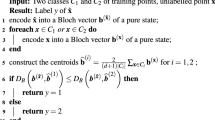Abstract
We present a novel approach to computing Hamming distance and its kernelisation within Topological Quantum Computation. This approach is based on an encoding of two binary strings into a topological Hilbert space, whose inner product yields a natural Hamming distance kernel on the two strings. Kernelisation forges a link with the field of Machine Learning, particularly in relation to binary classifiers such as the Support Vector Machine (SVM). This makes our approach of potential interest to the quantum machine learning community.
R. Nagarajan—Partially supported by EU ICT COST Action IC1405 “Reversible Computation Extending Horizons of Computing”.
D. Windridge—Supported by EU Horizon 2020 research project No. 731593 “Dream-like simulation abilities for automated cars (DREAMS4CARS)”.
Access this chapter
Tax calculation will be finalised at checkout
Purchases are for personal use only
Similar content being viewed by others
Notes
- 1.
The distant union of two arbitrary links L and M, denoted by \( L \sqcup M\) is obtained by first moving L and M so that they are separated by a plane, and then taking the union.
References
Adams, C.: The Knot Book. W.H. Freeman, New York (1994)
Aharonov, D., Jones, V., Landau, Z.: A polynomial quantum algorithm for approximating the Jones polynomial. In: Proceedings of the 38th Annual ACM Symposium on Theory of Computing, Seattle, WA, USA, 21–23 May 2006, pp. 427–436 (2006)
Alexander, J.W.: A lemma on systems of knotted curves. Proc. Natl. Acad. Sci. U.S.A. 9(3), 93–95 (1923)
Markoff, A.: Uber die freie äquivalenz der geschlossenen zöpfe. Rec. Math. [Mat. Sbornik] N.S. (1936)
Cortes, C., Vapnik, V.: Support-vector networks. Mach. Learn. 20(3), 273–297 (1995)
Freedman, M.H.: P/NP, and the quantum field computer. Proc. Natl. Acad. Sci. 95(1), 98–101 (1998)
Freedman, M.H., Kitaev, A., Wang, Z.: Simulation of topological field theories by quantum computers. Commun. Math. Phys. 227, 587–603 (2002)
Hamming, R.W.: Error detecting and error correcting codes. Bell System Tech J. 29, 147–160 (1950)
Jones, V.F.R.: A polynomial invariant for knots via von Neumann algebras. Bull. Amer. Math. Soc. (N.S.) 12(1), 103–111 (1985)
Kauffman, L.H.: State models and the Jones polynomial. Topology 26(3), 395–407 (1987)
Kauffman, L.H.: New invariants in the theory of knots. Am. Math. Monthly 95(3), 195–242 (1988)
Kauffman, L.H.: Knots and Physics. Series on Knots and Everything, 4th edn. World Scientific, Singapore (2013)
Kitaev, A., Preskill, J.: Topological entanglement entropy. Phys. Rev. Lett. 96, 110404 (2006)
Kitaev, A.: Fault-tolerant quantum computation by anyons. Ann. Phys. 303(1), 2–30 (2003)
Pachos, J.K.: Introduction to Topological Quantum Computation. Cambridge University Press, New York (2012)
Reidemeister, K.: Knoten und Gruppen. Springer, Heidelberg (1932). https://doi.org/10.1007/978-3-642-65616-3
Reidemeister, K.: Elementare begründung der knotentheorie. Abhandlungen aus dem Mathematischen Seminar der Universität Hamburg 5(1), 24–32 (1927)
Satō, H.: Algebraic Topology: An Intuitive Approach. Iwanami Series in Modern Mathematics. American Mathematical Society, Providence (1999)
Wilczek, F.: Quantum mechanics of fractional-spin particles. Phys. Rev. Lett. 49, 957–959 (1982)
Author information
Authors and Affiliations
Corresponding author
Editor information
Editors and Affiliations
Rights and permissions
Copyright information
© 2017 Springer International Publishing AG
About this paper
Cite this paper
Di Pierro, A., Mengoni, R., Nagarajan, R., Windridge, D. (2017). Hamming Distance Kernelisation via Topological Quantum Computation. In: Martín-Vide, C., Neruda, R., Vega-Rodríguez, M. (eds) Theory and Practice of Natural Computing. TPNC 2017. Lecture Notes in Computer Science(), vol 10687. Springer, Cham. https://doi.org/10.1007/978-3-319-71069-3_21
Download citation
DOI: https://doi.org/10.1007/978-3-319-71069-3_21
Published:
Publisher Name: Springer, Cham
Print ISBN: 978-3-319-71068-6
Online ISBN: 978-3-319-71069-3
eBook Packages: Computer ScienceComputer Science (R0)




